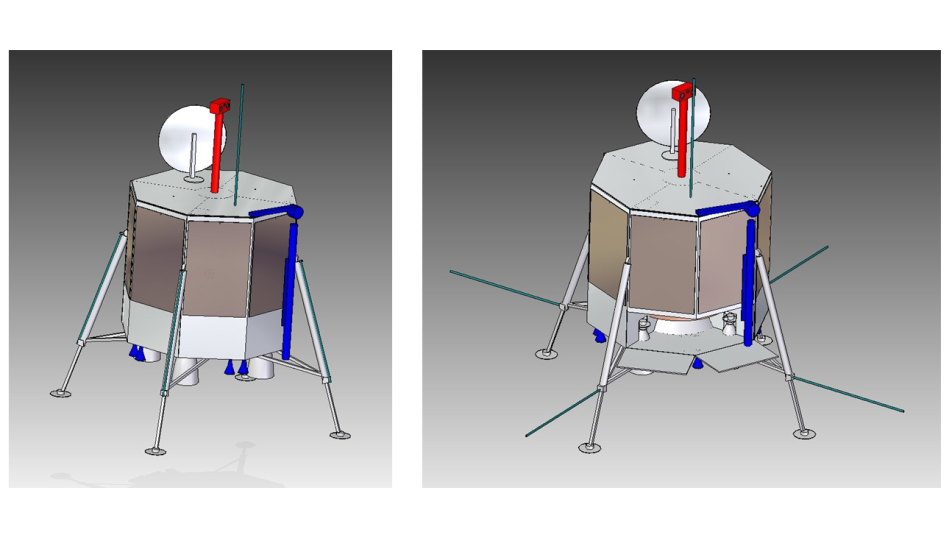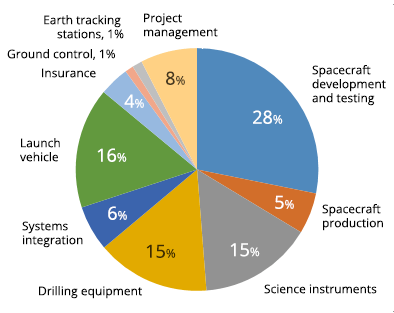The Cost Case
Introduction
At the top level, Lunar Mission One can be considered to have two cost components under parallel development. The space mission itself, with all its planning and development work, is approximately a fixed cost, though its parts can vary with management. The public engagement is variable depending on the take-up, in both sales and education. With current forecasts of take-up, both components are roughly similar in value. Apart from education each is led by supplier management under contracts arranged by Lunar Missions Ltd.
Space Mission Costs
The mission cost prediction comes from a technology feasibility study undertaken in 2012 at the Rutherford Appleton Laboratory in Harwell, UK, by a team of professional engineers. Using a recently installed integrated software package for creating mission architectures, known as a Concurrent Design Facility, the team was tasked with working out how to take a payload of archive canisters, a suite of science instruments and a deep drill to the Moon’s South Pole.
The team assumed a commercially managed mission development and operation. It produced an outline reference spacecraft design and mission flight profile, investigated the status of the key technologies that require development, predicted the costs and timings based on historic space projects, and assessed the risks to cost and timescale.
It determined that many of the components can be bought in, such as the motors and fuel tanks, solar panels and electric power systems, communications equipment and the rocket to launch it all into space. Some components need development, in particular the remote controlled drilling operations and precision landing. The team presumed the use of drilling technology originally prototyped in the US in the 2000’s, as shown below, but still needing up to $100m to develop to an operational version from its current status of TRL 5 (Technology Readiness Level - see http://en.wikipedia.org/wiki/Technology_readiness_level).


The team created a reference design for a spacecraft, as shown below, weighing 700 Kg without fuel, to carry 135 Kg of payload including canisters, instruments, the drill and a robotic arm. The total mass when landed is 835 Kg.

Taking everything into account, the study predicted a mission cost around $750m, with a ten year project timescale. This included two extra years of contingency to cover drilling risk, and three years for setting up the main commercial contracts.
The mission cost prediction is itemised below.
| Spacecraft development and testing | $212m |
| Spacecraft production | $41m |
| Science instruments | $114m |
| Drilling & canisters | $114m |
| Systems integration | $45m |
| Launch vehicle | $121m |
| Insurance | $30m |
| Ground control | $9m |
| Earth tracking stations | $10m |
| Project management | $57m |
| Total | $751m |

For more details on the space technology review, see Technical Review.
Lunar Mission One can expect funding support from government, from local to national. By their nature, space exploration projects create innovations that can have long term economic value, beyond commercial business cases but within the scope of government policy. This project holds potential for several areas of science and new technology, in lunar science and astronomy, geoscience and technology, materials and nanotechnology, robotics and systems.
Of particular economic potential are improvements in:
- The safety of remote controlled drilling on Earth, benefitting the industrial exploration for natural resources and the environmental sector.
- High integrity navigation from Lunar Mission One’s precision landing.
- Remote and local sensing from the science instruments carried by the lander.
Government support is normally acquired by universities for science and by industry for technology. Lunar Mission One’s central project would see such support as a resulting cost reduction, as industry and universities can pass on the funding benefits. By funding innovation, Government support is also most likely in those areas where costs are most uncertain, so helping to reduce the prospect of cost overruns.
At this stage, costs are only estimates. The uncertainty will reduce as technology development gets underway, and as supplier management becomes more confident about the detail of the risks it has to control. Special measures may be needed in the event that the revenue forecast becomes significantly lower and jeopardises the funding of the project as planned. The project’s due diligence has identified risks that may cause such a scenario and will manage any resulting difficulties.
The three year Setup Stage which starts this year will lead to a much better prediction of mission cost, together with more detailed management plans for its control. This stage is expected to cost about $20m, plus $10m-$15m for suppliers costs as they plan and prepare for the mission contract.
Public Engagement Costs
Sales and marketing costs need to cover:
- The definition of the core product and associated products and services.
- The public awareness and understanding of the offer.
- The sales process and its execution.
- The fulfilment, reporting and audit processes.
- Customer support throughout.
The main campaign requires capital investment to create a package for the regionally contracted management of local promotion and sales. It would include marketing and branding collateral, a software package for front office and help desk operations, and further software for back office processing and accounting. It would all be supported by the central management of marketing and product development, to be maintained as the campaign develops, together with the maintenance and support of the package for local operations.
Regional management invests to set up its own arrangements, making a financial return through sales after paying for its local operations and a licence fee for the centrally produced package. So from Lunar Mission One’s point of view, it sees a proportional cost of sales taken by the sales resource.
From operating models for outsourced business, typically from contracts in the IT sector, the project anticipates a fixed cost to create the initial sales and marketing package of around $30m, followed by a variable amount taken as a percentage of gross revenues of 10% for local sales and a further 2.5% for central marketing. Local taxes may influence the commercial arrangements.
For the mid-point revenue prediction of $4.5Bn, the variable sales and marketing cost predictions are $112m for central and $450m for local. With the initial package cost, that totals just under $600m.
The educational public engagement is treated outside of the commercial business case on the grounds that it will be funded by the project’s educational side, now underway with the support of local volunteers and normal fundraising activities. It will largely be dependent on the extent of the schools programme and the way it is managed. We currently envisage that it is unlikely to be less than a few tens of millions of dollars, or more than a few hundreds of millions.
